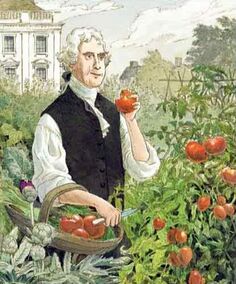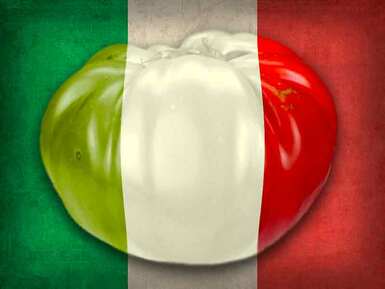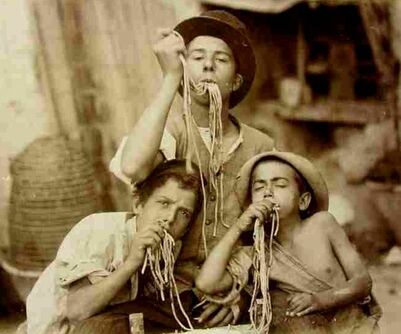 On the 6th of January every year, La Befana, the Italian witch, delivers treats to children across Italy, just as Babbo Natale does on Christmas Eve. But la Befana is a witch (albeit, a good one) who travels by broom, magically swishing down chimneys and leaving presents in children's pillow cases, stockings and shoes. In her hometown of Urbania--in the region of Marche--50,000 Italians celebrate this good witch's arrival with literally tons of desserts and foods. Throughout the streets and piazzas, you will find theater performances, fire-eaters, la Befana on stilts and also be amazed when she flies overhead (on a cable). The Festa Nazionale della Befana gives an alternative insight of holiday celebrations... it's perhaps one of the best festivals of the holiday season. --GVI Click on the photo above to watch a video of this festival
 If you look in my cellar during mid-May of any year, you will find a couple of dozen young tomato plants under my grow light, nearly ready to be planted out in my raised vegetable beds (after fear of frost is gone). My mind always fills with thoughts of tomatoes in this time of year, with hope that there will be a good yield for our little famiglia. If I say, "tomato sauce" you think of Italian food, right? If I say "home grown tomatoes" you might think of Vito Corleone playing with his grandson in his garden in that final scene in his life. If I say "pizza" you picture a round crust with cheese and tomato sauce. That red color emblazoned in the minds and hearts of Italians everywhere (even though heirloom tomatoes come in many colors). Some say that Il Tricolore (the tricolor flag of Italy) represents the hills of Italy with green, the snow capped mountains with white, and the blood spilled from the wars of independence by red. But others in la Cucina Italiana would argue that the green is for pesto, the white for besciamella and the red for salsa pomodoro found in tri-color lasagna... or that the flag represents the simple but wonderful insalata caprese: green for basil, white for mozzarella, and the red for ripe tomatoes. In any case, you might say the red in Il Tricolore represents the true blood of Italy--the tomato.  The Wild Tomato of Peru The Wild Tomato of Peru But how did the tomato become such a strong part of Italian culture? It is not indigenous to Italy, or Europe for that matter. The tomato was first "discovered" by the Spanish Conquistadors while exploring and then conquering the Americas. The Spaniard, Hernán Cortés, conqueror of Mexico in 1519, returned home and brought with him a cargo of Aztec tomatoes. The tomato most likely originated in the Andes mountains of Peru and spread sometime in the distant past to most parts of South and Central America and eventually on up to Mexico. In fact, it was the Incas who first cultivated tomatoes about 1000 years ago, eventually trading seeds to Aztecs and Mayans to the North. Most botanists consider the tiny, scraggly bush Solanum Pimpinellifolium (or "Pimp") as the ancestor of all modern tomatoes, itself becoming an endangered species. The odd thing is that the tomato became popular in Europe long before it came to be used in North America. Colonial Americans thought of the tomato as a poisonous plant, after all, it's a close cousin or Nightshade, a well know toxic vine, and in fact, the leaves and vines of the tomato plant are fairly toxic.  16th century botanical illustration 16th century botanical illustration It was during the 1500s that Columbus and other explorers introduced the tomato to Europe, but 200 years of skepticism had to pass before the tomato gained acceptance there. It was feared that one touch of a tomato on the lips would kill you. One likely catalyst for its popularity in Europe, especially with the wealthy and elite, was the rumor that it was an aphrodisiac. The general population more than likely heard about this new fruit and saw that the Barons and Dukes behind the castle walls were flourishing, not falling down dead. One can imagine that the trash middens where refuse from the castles, chateaus and villas were thrown, became a great source of distribution for the tomato plant. As anyone who grows tomatoes knows, tomatoes are prolific and seeds can spring up anywhere. Leave a fruit on the ground and chances are good you'll have more tomatoes next year. Leave a tomato on the kitchen counter and the seeds might eventually sprout right out of its own skin.  Self-Sprouting Tomato Self-Sprouting Tomato Little by little, the peasants discovered gnarly vines growing wild with attractive red or yellow fruits that were attracting wild life. (Chipmunks love them in my garden!) "Why not give them a try? The birds, squirrels and rabbits aren't dying, after all." Presto... a free, easily grown source of vitamins and amazing flavor. It was easy to save seeds and cultivate a very large harvest from even a modest number of plants. The word tomato is derived from the Aztec word xitomatl, shortened in Europe to tomatl. The French originally called the tomato, pomme d’amour (love apple) before calling simply la tomate. Perhaps they changed the name when the aphrodisiac claims failed to yield any effect. In Italy it was pomi d’oro (golden apple) which today becomes il pomodoro. Tomatoes do come in a wide variety of colors, including golden yellow, but along with tomatoes, the tomatillo also came from the Americas--many of which are also yellow. In Italy, the tomato more than likely prospered because of its near-tropical climate. The tomato can be grown all year long in tropical temperatures. It makes sense the Spanish had tomatoes first, after all, they sponsored the Columbus and Cortes explorations. In this way, Spaniards actually led the way, "teaching" Italians to fry tomatoes up with eggplant, squash and onions, and used the dish as a condiment on bread and with meats. The cuisine of Southern Italian peasants, who often lacked meats and other proteins on a regular basis, developed into a mostly vegetarian diet in which tomatoes and olive oil, spices and vegetables were and eaten with bread, rice or polenta. The first time the pomi d'oro is mentioned by name in Italy was in 1548 in the household records of Cosimo de’Medici, the grand duke of Tuscany. His house steward presented a basket to “their excellencies”. The Duke had no idea what was inside, only that it came from his Florentine estate at Torre del Gallo. The records describe the scene, “And the basket was opened and they looked at one another with much thoughtfulness.” After the event, the house steward wrote to the Medici private secretary to tell him that the basket "arrived safely". But as far back as 1692, tomatoes were used as ingredients in a cookbook from Naples, Lo scalco alla moderna. The author obviously copied details from Spanish tomato sauce recipes ("alla spagnuola"), including simple ingredients like minced tomatoes and chili peppers. Curiously, he did not recommend using the sauce specifically with pasta: "Take a half a dozen tomatoes that are ripe, put them to roast in the embers, when they are scorched, remove the skin diligently, then mince them finely with a knife. Add onions, minced finely, to discretion. Hot chili peppers, also minced finely. Add thyme, in a small amount. After mixing everything together, adjust it with a little salt, oil, and vinegar. It is a very tasty sauce, both for boiled dishes or anything else." Italian nobility at first used this new, jewel-like fruit merely as a tabletop decoration, gradually incorporating it into their cuisine by the late 17th and early 18th century. They cherished their beauty, and experimented with selective breeding, managing to create tomatoes of many colors and shapes  It took another 200 years for the tomato to become the national treasure is it today, but by the late 1700s, the peasants of Naples began to put tomatoes on top of their flat breads, creating something very close to the modern pizza--essentially turning pizzas from white to red. Tomatoes gained popularity, especially with the elite of Europe and Americans taking the Grand Tour, and soon pizza attracted tourists to Naples, tempting them into the poor areas of the city to sample the new treat. Pizza was born. Soon after taking a Grand Tour himself, Thomas Jefferson, being an expert farmer and a culinary expert, brought tomato seeds back from Europe. Jefferson grew tomatoes in his expansive Monticello garden, with his daughters and granddaughters using them in numerous recipes including gumbo, soups, pickling and especially for ketchup (the common use for tomatoes in the 19th century). In an 1824 speech to the Albemarle Agricultural Society, Jefferson’s son-in-law, Thomas Mann Randolph, claimed that ten years before, the tomato was barely known, but by 1824 "everyone was growing and eating them". Slow but sure, people were taking notice of this special fruit.  Pizza Margherita, the birth of modern pizza Pizza Margherita, the birth of modern pizza In the same time period we find the first recorded evidence of tomatoes used in sauces and preserved condiments and pastes. In the 1800s, in Naples a recipe was written about pasta al pomodoro, the very first mention of tomatoes being married to pasta. In 1889, after Italy became one nation, the King and Queen of Italy found it necessary to visit the former kingdom of Naples to appease the citizenry who disliked their loss of independence. Queen Margherita was bored with the same old French cuisine that they were eating everywhere they went--as was the custom in all of Europe. She called for the most famous pizza-maker in Naples, Raffaele Esposito, and commanded that he make pizza for her. He brought three types: pizza marinara with garlic, pizza Napoli with anchovies and a third with tomato sauce, mozzarella and basil leaves. She fell in love with the third one and Esposito named it after her--Pizza Margherita. A short time later, the Queen sent her emissary with a thank you note, which still today hangs on the wall of Pizzeria Brandi, still run by his descendants. Pizza--with tomato sauce--was to become more popular than ever after the Queen's royal recommendation--the equivalent to Royal Yelp nowadays. Emigration to the United States did more to increase the popularity of the tomato than anything else in history. Because of the climate in Italy, tomatoes became a big crop, even small farmers produced an excess of the sweet fruits. A need developed to preserve them, and to create new markets. The only foods that may be safely canned in an ordinary boiling water bath are highly acidic ones--coincidentally, tomatoes are naturally high in acid. Sun drying tomatoes and storing them in olive oil was also a proven way to preserve large stores of tomatoes, as long as no fresh herbs or garlic were added, the method a safe with a long shelf life. During the mid-1800s the science of canning started to develop and improve, allowing this new cash crop to find its way to distant markets. By the end of the 19th century Italians were already using tomatoes in their recipes and as a condiment. When Italians emigrated to America, they wanted to have products that reminded them of home... canned tomatoes filled that need, along with olive oil and other specialty imports. Italians at home and expats in American developed import-export businesses to give relatives and other their compagni jobs based on their new found wealth in America. In Italy, exporting companies were popping up, especially in the Naples area. By the time World War I rolled around, even the Italian Army experimented with canned ravioli, spaghetti alla bolognese and Pasta e fagioli, the inclusion of acidic tomatoes in the recipes aided in the cans' shelf life. Italian grocery stores stocked these products in Little Italy neighborhoods in New York, Philadelphia, Chicago, Boston and New Orleans. Click HERE to read Part 2 |
On AMAZON:
|













 RSS Feed
RSS Feed

